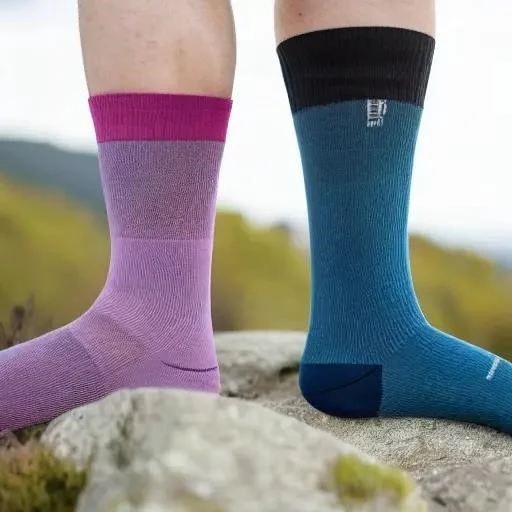
For too long, the humble sock has been relegated to an afterthought in the grand tapestry of outdoor gear․ Hikers meticulously research boots, pore over backpack specifications, and agonize over jacket breathability, yet often grab the nearest pair of cotton socks before hitting the trail․ This oversight, however, is a critical misstep, one that can transform a breathtaking wilderness trek into an agonizing ordeal of blisters, discomfort, and premature fatigue․ Imagine scaling a majestic peak, only to have your focus shattered by searing friction or perpetually damp feet․ The truth is, your socks are not just a barrier between your foot and your boot; they are a sophisticated piece of engineering, a vital interface designed to optimize your entire hiking experience․
The landscape of outdoor apparel has evolved dramatically, with innovations extending far beyond the visible layers․ Today’s hiking socks are a testament to this progress, crafted from cutting-edge materials and designed with ergonomic precision to tackle diverse challenges․ They are engineered to manage moisture, regulate temperature, cushion impact, and prevent the dreaded hot spots that can quickly derail an adventure․ By embracing these advancements, outdoor enthusiasts are discovering unprecedented levels of comfort and performance, transforming arduous journeys into purely joyful explorations․ Understanding the science and strategy behind modern hiking socks is not merely about preventing discomfort; it’s about unlocking your full potential on the trail, ensuring every step is as confident and comfortable as the last․
Essential Hiking Sock Materials & Characteristics
Choosing the right hiking socks hinges on understanding the core properties of their constituent materials․ Here’s a breakdown of the key players:
| Characteristic | Description | Ideal Use Case | Considerations & Tips |
|---|---|---|---|
| Material: Merino Wool | Naturally soft, breathable, excellent temperature regulation (warm in cold, cool in heat), superb moisture-wicking, naturally odor-resistant․ | All-season hiking, multi-day treks, cold weather, sensitive skin․ | Can be more expensive; requires gentle washing․ Look for varying thicknesses․ |
| Material: Synthetics (Polyester, Nylon, Polypropylene) | Highly durable, exceptionally quick-drying, excellent moisture-wicking․ Often blended for enhanced performance․ | Warm weather hiking, wet conditions, high-intensity activities․ | Can retain odors more than wool; less natural feel․ Blends often offer the best of both worlds․ |
| Material: Blends (Wool & Synthetics) | Combines the best attributes of both: the comfort, temperature regulation, and odor resistance of wool with the durability and quick-drying properties of synthetics․ | Versatile for most hiking conditions, provides balanced performance․ | The specific ratio of materials will dictate performance; check composition․ |
| Cushioning Levels | Varies from ultra-light (minimal padding, maximum breathability) to heavy (maximum padding, warmth, and protection)․ | Light: Warm weather, trail running; Medium: Day hikes, varied terrain; Heavy: Cold weather, heavy packs, rugged terrain․ | Match cushioning to your boot fit and activity level․ Too much padding can cause friction if boots are tight․ |
| Fit & Construction | Snug, anatomical fit with no bunching․ Seamless toe closures prevent irritation, arch support reduces fatigue, and specific cuff heights prevent debris entry․ | Crucial for all hiking to prevent blisters and ensure comfort․ | Try socks on with your hiking boots before purchase․ Ensure they don’t slip down or wrinkle․ |
The Unsung Heroes: Why Material Matters More Than You Think
At the heart of superior hiking socks lies the science of materials; Merino wool, an industry darling, reigns supreme for its incredible versatility․ Unlike its scratchier conventional counterpart, Merino wool fibers are exceptionally fine, providing a luxuriously soft feel against the skin․ Its natural crimp creates air pockets, offering remarkable insulation in cold conditions while simultaneously wicking moisture away to keep feet cool and dry in warmer temperatures․ Furthermore, Merino’s inherent antimicrobial properties naturally resist odor-causing bacteria, a blessing on multi-day treks․ As Sarah Jenkins, a seasoned Appalachian Trail thru-hiker, eloquently puts it, “Merino wool isn’t just a material; it’s a game-changer․ It’s the silent partner that keeps my feet happy, mile after grueling mile․”
Equally vital are advanced synthetics like polyester, nylon, and polypropylene․ These engineered fibers excel in rapid moisture transport and quick-drying capabilities, making them an incredibly effective choice for high-intensity activities or very wet environments․ Brands such as Darn Tough and Smartwool have perfected sophisticated blends, synergistically combining the best attributes of both wool and synthetics․ By integrating insights from textile science, these innovative blends offer the durability and fast drying of synthetics alongside the comfort and odor resistance of Merino, creating a remarkably balanced and high-performing product․ This thoughtful approach ensures hikers can tackle any trail, in any weather, with confidence․
Beyond Fabric: Cushioning, Fit, and the Future of Footwear
However, material selection is merely the first step․ The architecture of the sock itself plays an equally crucial role․ Cushioning levels, for instance, are meticulously engineered to match specific activities and terrains․ Lightweight socks offer minimal padding for maximum breathability during warm-weather day hikes, while medium-cushioned options provide balanced comfort for general use․ For backpacking with heavy loads or navigating rugged, challenging terrain in colder climates, heavily cushioned socks absorb impact and provide essential warmth․ The importance of a precise fit cannot be overstated; a sock that bunches, slips, or is too tight inevitably leads to friction and blisters, negating the benefits of even the finest materials․
Looking ahead, the future of hiking socks is bright and brimming with innovation․ We are witnessing the integration of advanced technologies, including targeted compression zones to enhance blood circulation and reduce muscle fatigue, and sophisticated weaving techniques that create seamless, anatomical fits designed to mirror the foot’s natural contours․ Leading manufacturers are investing heavily in research and development, constantly pushing the boundaries of what’s possible․ These exciting developments promise even greater comfort, resilience, and performance, ensuring that every hiker, from the casual weekend explorer to the dedicated thru-hiker, can experience the profound joy of the outdoors without the distraction of aching feet․ The evolution of the hiking sock is not just about improved gear; it’s about fostering a deeper, more immersive connection with nature․
